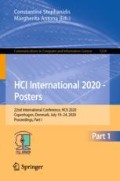Abstract
This work proposes a novel approach to visually interact with semantic networks constructed via natural language processing techniques. The proposed web interface, WINS, allows the user to select a textual document to be analyzed, choose the algorithm to construct the semantic network, and visualize the network with its metrics. Unlike previous works, which are typically based on co-occurrence matrix for constructing the text network, the proposed interface embeds an additional approach based on the combination of network science with distributed representations of words and phrases.
Access this chapter
Tax calculation will be finalised at checkout
Purchases are for personal use only
Notes
- 1.
- 2.
Chunking, n-gramming are text pre-processing phases to segment raw text into these units [2].
- 3.
Proximity can be quantified with any spatial proximity measurement; for example, using euclidean distance, or cosine distance.
- 4.
The term “card” refers to the HTML division class used for the aesthetic layout design.
- 5.
Dimensionality of vectors has been reduced to two components. This can be achieved with different techniques with some limitations as discussed by the authors of [14].
References
Blondel, V.D., Guillaume, J.L., Lambiotte, R., Lefebvre, E.: Fast unfolding of communities in large networks. J. Stat. Mech: Theory Exp. 2008(10), P10008 (2008)
Borrelli, D., Gongora Svartzman, G., Lipizzi, C.: Unsupervised acquisition of idiomatic units of symbolic natural language: an n-gram frequency-based approach for the chunking of news articles and tweets. Plos one 15(6), e0234214 (2020)
Danowski, J.A.: WORDij: a word-pair approach to information retrieval. NIST Special Publication, no. 500207, pp. 131–136 (1993)
Diesner, J.: Context: software for the integrated analysis of text data and network data. Social semantic networks in communication research (2014)
Diesner, J., Carley, K.M.: AutoMap 1.2: extract, analyze, represent, and compare mental models from texts. Carnegie Mellon University, School of Computer Science, Institute for ... (2004)
Doerfel, M.L.: What constitutes semantic network analysis? A comparison of research and methodologies. Connections 21(2), 16–26 (1998)
Drieger, P.: Semantic network analysis as a method for visual text analytics. Procedia-Soc. Behav. Sci. 79(2013), 4–17 (2013)
Harris, Z.: Distributional structure. Word 10(2–3), 146–162 (1954). Reprinted in Fodor, J.A., Katz, J.J. (eds.) Readings in the Philosophy of Language
Khanfor, A., Ghazzai, H., Yang, Y., Massoud, Y.: Application of community detection algorithms on social internet-of-things networks. In: 2019 31st International Conference on Microelectronics (ICM), pp. 94–97. IEEE (2019)
Lipizzi, C., Dessavre, D.G., Iandoli, L., Marquez, J.E.R.: Towards computational discourse analysis: a methodology for mining twitter backchanneling conversations. Comput. Hum. Behav. 64, 782–792 (2016)
Lipizzi, C., Iandoli, L., Marquez, J.E.R.: Extracting and evaluating conversational patterns in social media: a socio-semantic analysis of customers’ reactions to the launch of new products using Twitter streams. Int. J. Inf. Manag. 35(4), 490–503 (2015)
Lipizzi, C., Iandoli, L., Marquez, J.E.R.: Combining structure, content and meaning in online social networks: the analysis of public’s early reaction in social media to newly launched movies. Technol. Forecast. Soc. Change 109, 35–49 (2016)
Lipizzi, C., Verma, D., Korfiatis, G., Borrelli, D., Capela, F., Clifford, M., Desai, P., Giffin, R., Hespelt, S., Hoffenson, S., et al.: Meshing capability and threat-based science and technology (S and T) resource allocation. Technical report, Stevens Institute of Technology Hoboken United States (2019)
Liu, S., Bremer, P.T., Thiagarajan, J.J., Srikumar, V., Wang, B., Livnat, Y., Pascucci, V.: Visual exploration of semantic relationships in neural word embeddings. IEEE Trans. Vis. Comput. Graph. 24(1), 553–562 (2017)
Lund, K., Burgess, C.: Producing high-dimensional semantic spaces from lexical co-occurrence. Behav. Res. Methods Instrum. Comput. 28(2), 203–208 (1996)
Mikolov, T., Sutskever, I., Chen, K., Corrado, G.S., Dean, J.: Distributed representations of words and phrases and their compositionality. In: Advances in Neural Information Processing Systems, pp. 3111–3119 (2013)
Paranyushkin, D.: Infranodus: generating insight using text network analysis. In: The World Wide Web Conference, pp. 3584–3589 (2019)
Primario, S., Borrelli, D., Iandoli, L., Zollo, G., Lipizzi, C.: Measuring polarization in Twitter enabled in online political conversation: the case of 2016 us presidential election. In: 2017 IEEE International Conference on Information Reuse and Integration (IRI), pp. 607–613. IEEE (2017)
Taskin, Y., Hecking, T., Hoppe, H.U.: ESA-T2N: a novel approach to network-text analysis. In: International Conference on Complex Networks and Their Applications, pp. 129–139. Springer, Cham (2019)
Acknowledgements
This material is based upon work supported, in whole or in part, by the U.S. Department of Defense through the Office of the Assistant Secretary of Defense for Research and Engineering (ASD(R&E)) under Contract [HQ0034-19-D- 0003, TO#0150].
Author information
Authors and Affiliations
Corresponding author
Editor information
Editors and Affiliations
Rights and permissions
Copyright information
© 2020 Springer Nature Switzerland AG
About this paper
Cite this paper
Borrelli, D. et al. (2020). WINS: Web Interface for Network Science via Natural Language Distributed Representations. In: Stephanidis, C., Antona, M. (eds) HCI International 2020 - Posters. HCII 2020. Communications in Computer and Information Science, vol 1224. Springer, Cham. https://doi.org/10.1007/978-3-030-50726-8_80
Download citation
DOI: https://doi.org/10.1007/978-3-030-50726-8_80
Published:
Publisher Name: Springer, Cham
Print ISBN: 978-3-030-50725-1
Online ISBN: 978-3-030-50726-8
eBook Packages: Computer ScienceComputer Science (R0)

